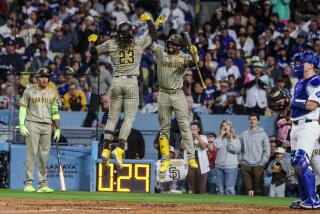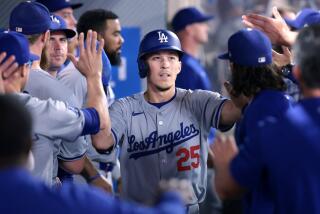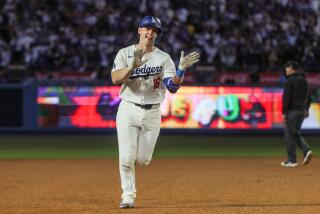Seeking a New Trademark : Baseball: Padre Phil Stephenson would like to put Pick-Off Play behind him.
SAN DIEGO — Most players arrive in the major leagues looking to make impressions.
Phil Stephenson would settle for making memories.
By now, he figured, after a standout career at Wichita State and 10 seasons in professional baseball, people would remember his home runs. Or RBIs. Or clutch hits. Or stolen bases. Something.
Instead, as Stephenson continues his comeback from knee surgery after being recalled by the Padres on Monday from triple-A Las Vegas, there is one moment with which many people continue to associate him.
The Pick-Off Play in the 1982 College World Series.
In case anyone forgets, ESPN dredges it up each spring during the College World Series.
“I should probably call ESPN and get royalties,” Stephenson said. “I’ll be 50, 60 years old and they’ll probably still be showing it.
“All the records I still hold from (college) and to be remembered for that, it’s sickening.”
Yes, Stephenson, who will platoon in left field with either Jerald Clark or Kevin Ward, still holds NCAA career records for hits, stolen bases, total bases, walks and runs scored, among other things.
But it all takes a back seat to the time when Stephenson was standing on first base against the University of Miami in 1982. The Miami pitcher threw to first once, then stepped off of the rubber and made a throwing motion again.
That’s when it started.
The Miami first baseman made like he was diving for the ball.
The Miami bench started screaming that the ball had gone down the right-field line.
The players in the Miami bullpen down the right-field line leaped up, moving their chairs and scattering.
The acting was so good that the first base umpire started frantically looking down the right-field line for the ball.
And Wichita State’s own first base coach, Brian Oelkers, began yelling for Stephenson to go to second.
So he did.
And the Miami pitcher calmly took the ball out of his glove, threw to second and nailed Stephenson.
“He’ll go down in history for that,” Padre catcher Dann Bilardello said. “Every College World Series, they show it. We’re always mentioning it to him, making sure he doesn’t get a big head.
“It’s not a bad way of being famous, really. It’s something I’d like to be famous for.”
Stephenson certainly never dreamed that this would be his ticket to recognition. But after suffering a knee injury in 1990, just when it looked like his career was set to shift into fifth gear, he has spent nearly two seasons trying to get healthy.
“Since the end of June, 1990, things have seemed like they are in slow motion,” Stephenson said. “After I hurt my knee that year, I was not the same player I was in the first half of that season.”
After bouncing around the minors for most of eight summers, Stephenson was in his first full major league season in 1990 when he twisted his knee in Houston.
The injury was eventually diagnosed as avascular necrosis, the same thing Bo Jackson had in his hip. There was a part of Stephenson’s knee to which blood was not flowing, and that part of the knee was withering away.
He tried to play in 1991 before finally undergoing surgery on Aug. 16. Although avascular necrosis can be career ending, Stephenson said the doctors never told him that his career was threatened.
“I don’t think anybody ever really wants to tell you that,” Stephenson said. “I never thought I was done. But some days, when you’re going through rehab, you’ve got to wonder.”
And since that time, the Padres have acquired Fred McGriff, who happens to play first base, the position Stephenson has occupied for most of his professional career. Not only did he have to rehabilitate his knee, he had to become reacquainted with left field.
“I knew the only way to make the ballclub out of spring training was to show them that I could play outfield,” Stephenson said. “The biggest question was how my knee would respond.”
Stephenson talked with several Padre officials about making a transition from the infield to the outfield during spring training.
“It says something about his determination,” Padre General Manager Joe McIlvaine said. “It’s like (Craig) Lefferts asking to be a starting pitcher. With veteran players, you never underestimate their determination. When they tell you something, you don’t slough it off.”
Usually, it’s the other way around after a player injures his knee. He must leave the outfield and all that running around for first base, where there is much less ground to cover.
“I’ve become more and more comfortable with it,” he said. “I’m not going to be a Gold Glove assist man, but I’m not going to make mistakes that cost the team runs.”
Stephenson did misjudge a ball in left field in the fifth inning Tuesday, but the Dodgers were held scoreless during the inning. But, as he also said, it will take him a few games to adjust to San Diego Jack Murphy Stadium.
The biggest thing, more than fly balls, is the leg itself.
“Since the start of the season, I’ve gotten more and more strength in my leg,” he said. “The muscles are starting to come back, I’ve got more confidence. I’ve lost a couple of steps but hopefully, as the leg strengthens, that will come back too.”
At the time of his recall, Stephenson was batting .332 with eight home runs and 43 RBIs for Las Vegas.
“He just needed at bats,” McIlvaine said. “When we sent him out, we wanted him to play every day. Personally, I thought he would be up here sooner, but it didn’t work out. He hit real well, but we just didn’t have an opening.”
With Clark struggling in left field (.190) and the Padres desperately looking for some punch in the bottom half of their lineup, an opening occurred. And after nearly two years of uncertainty, Stephenson is ready to jump back onto the track he left in 1990.
“Hopefully, I’ll get an opportunity, and the opportunity won’t be a week or two weeks,” he said. “Hopefully, it will be a lengthy period of time to see what I can do.”
But however wide his window of opportunity opens, Stephenson will have another chance to make something other than that Pick-Off Play the defining moment of his career.
“Maybe,” he said, “We can change some of that.”
More to Read
Go beyond the scoreboard
Get the latest on L.A.'s teams in the daily Sports Report newsletter.
You may occasionally receive promotional content from the Los Angeles Times.










